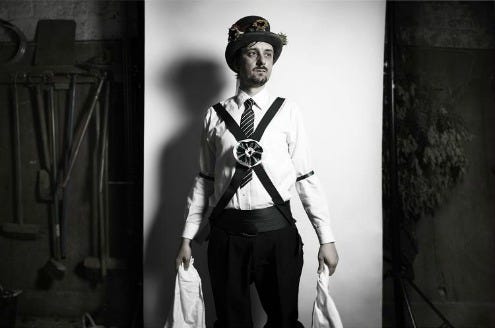Way of the Morris

For info and showtimes, click here.
I've often said that a good documentary can take an audience and put them in the middle of a community that seems strange, threatening or even ridiculous and make them relatable, or at least understandable.
"Way of the Morris" attempts that with a practice that seems — OK, absolutely is — completely ridiculous and laughable. Even the Morris Men, who practice the ancient, ludicrous art of the dance whose name they take, happily admit that what they do is silly and serves little purpose.
And yet Tim Plester manages to make their story a personal one — of the prodigal son who returns to the tiny English hamlet of Adderbury to confront his familial legacy with the Morris. A British actor of some note, Plester talks about how he was embarrassed by his father and uncle being Morris Men.
And there's much to be embarrassed about. The Morris dancers dress in white with a black baldric X'd across their chests, with bells strapped to their shins and foppish top hats decorated with flowers on their heads. They prance about in a way that is quite "ladylike," twirling large kerchiefs from their hands or knocking sticks about with their fellows.
They look like Alex's droogs from "A Clockwork Orange" gone gay.
And they do all this prancing to traditional folk music, often singing along to a ribald tune. One of their number, the Fool, dresses differently — the one in Adderbury wears a Darth Vader costume — to act as a conductor-slash-trickster to the merriment.
The modern-day village residents treat the Morris Men with something between disdain and affectionate acceptance. Plester calls the Morris tradition a "rural hangover" that most people would just as soon forget.
But the film probes deeper, looking at the muddled history of the Morris. Did it come from Africa or other parts of Europe, or was it brought back from the Holy Land during the Crusades? No one can really say.
All anyone knows is that it was a quaint pastoral tradition that died out for nearly six decades in Adderbury and was revived in the 1970s by Plester's father and some others. It even enjoyed a brief post-hippie heyday when a band called Fairport Convention cut a couple of albums of Morris music that topped the charts.
Even as he mocks the "curious white man's mambo," Plester is clearly intrigued by it or at least fascinated by his revulsion of it. He plumbs the history of his hometown and discovers that the Morris faltered because all of the Morris Men were killed during World War I except one man, Charlie Coleman, and when he returned, he didn't feel like dancing anymore.
The doc sometimes grows a little self-important and mystical; Plester and his co-director, Rob Curry, have a penchant for lingering shots of the Adderbury countryside while he intones some over-the-top narration with a quasi-religious tone. It reminded me of Terrence Malick's worst self-indulgent tendencies.
But there's a meaning to the Morris, at least to the men who do it, to continue an unruly tradition ingrained in their straitlaced local heritage, like a bright pink stripe in the mane of a proud lion. The English, who always seem terrified of looking silly, wear the expression well.
3.5 Yaps



